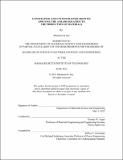| dc.contributor.advisor | Thomas W. Eagar. | en_US |
| dc.contributor.author | See, Marianna B. (Marianna Blackman) | en_US |
| dc.contributor.other | Massachusetts Institute of Technology. Department of Materials Science and Engineering. | en_US |
| dc.date.accessioned | 2013-09-24T18:22:44Z | |
| dc.date.available | 2013-09-24T18:22:44Z | |
| dc.date.copyright | 2013 | en_US |
| dc.date.issued | 2013 | en_US |
| dc.identifier.uri | http://hdl.handle.net/1721.1/80902 | |
| dc.description | Thesis (S.B.)--Massachusetts Institute of Technology, Dept. of Materials Science and Engineering, 2013. | en_US |
| dc.description | This electronic version was submitted by the student author. The certified thesis is available in the Institute Archives and Special Collections. | en_US |
| dc.description | Cataloged from student-submitted PDF version of thesis. | en_US |
| dc.description | Includes bibliographical references (p. 51-52). | en_US |
| dc.description.abstract | Production of materials which are limited by the amount available on the earth's surface follow a growth curve similar to the Avrami equation which governs the process of nucleation and growth. This thesis will analyze whether the product curve follows not only the same path but the same steps as the Avrami model: initially slow growth during an introductory period, accelerated growth during market acceptance, and declining growth following market saturation. This thesis will use two materials, steel and aluminum, as a case study to further understand the applicability of the Avrami model to production forecasts of materials available in finite or limited amounts. The aim of this project was to provide producers of various materials a model to use to predict when it would be profitable to invest in and enter a market and when not to do so. The framework developed provides a well-behaved model for the initial two stages, introduction and market acceptance, and forecasts the transition point between those two stages. However, due to lack of current data as neither aluminum nor steel have reached market saturation, a fit for the final stage and a forecast for the transition from market acceptance to market saturation has not yet been determined. | en_US |
| dc.description.statementofresponsibility | by Marianna B. See. | en_US |
| dc.format.extent | 54 p. | en_US |
| dc.language.iso | eng | en_US |
| dc.publisher | Massachusetts Institute of Technology | en_US |
| dc.rights | M.I.T. theses are protected by
copyright. They may be viewed from this source for any purpose, but
reproduction or distribution in any format is prohibited without written
permission. See provided URL for inquiries about permission. | en_US |
| dc.rights.uri | http://dspace.mit.edu/handle/1721.1/7582 | en_US |
| dc.subject | Materials Science and Engineering. | en_US |
| dc.title | Constrained and unconstrained growth : applying the Avrami Equation to the production of materials | en_US |
| dc.title.alternative | Applying the Avrami Equation to the production of materials | en_US |
| dc.type | Thesis | en_US |
| dc.description.degree | S.B. | en_US |
| dc.contributor.department | Massachusetts Institute of Technology. Department of Materials Science and Engineering | |
| dc.identifier.oclc | 858282832 | en_US |
